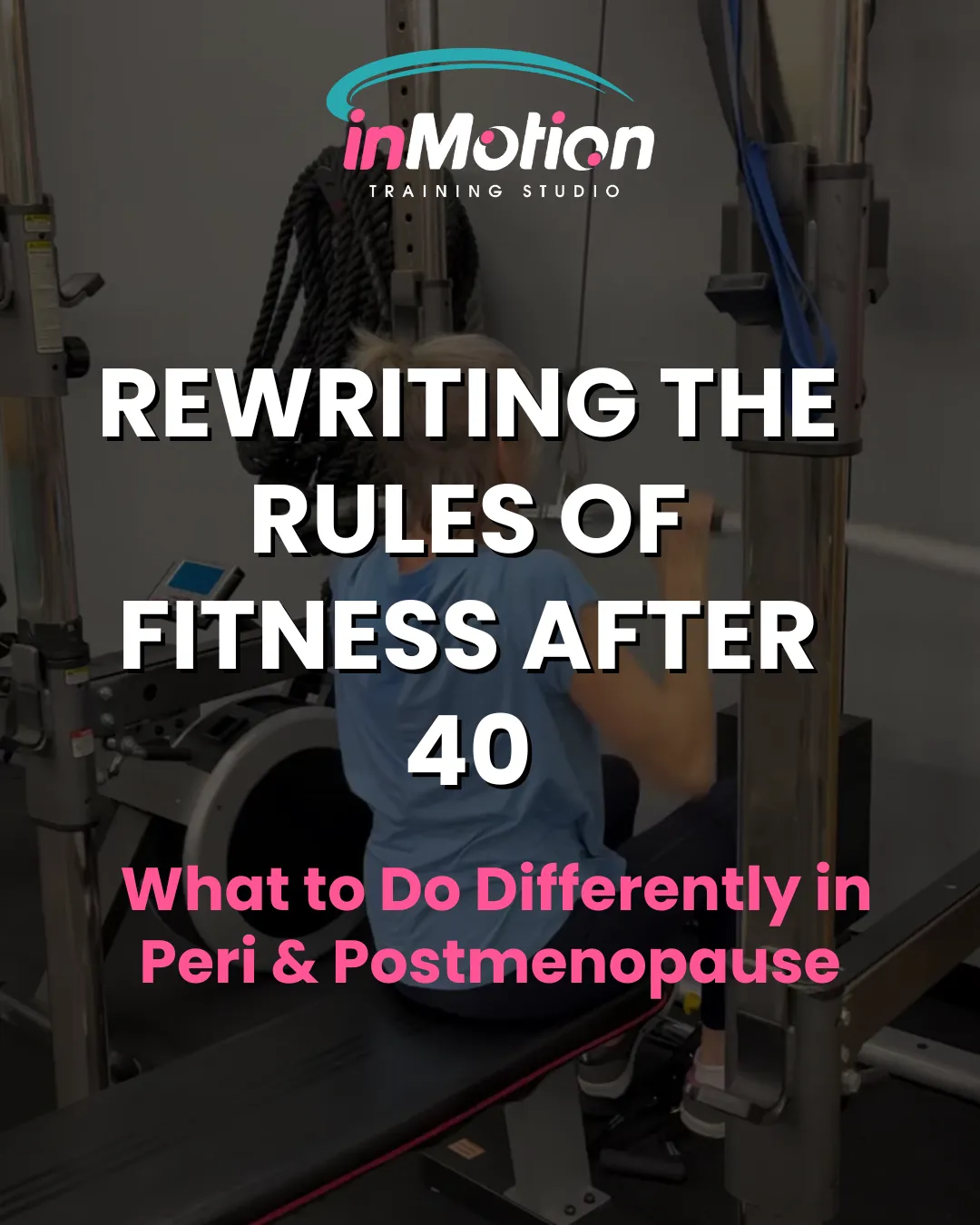
Rewriting the Rules of Fitness After 40: What to Do Differently in Peri & Postmenopause
Why Midlife Training Needs a Different Approach
If you’re in your 40s, 50s, or early 60s and starting to feel like your workouts don’t “work” the way they used to — you’re not crazy, and you’re not broken.
You’re just in a different hormonal environment.
Perimenopause is the transition phase — estrogen and progesterone start fluctuating, which can affect your energy, recovery, and even how your muscles and joints feel day to day.
Postmenopause is the new baseline — your hormones have stabilized at lower levels, and while that steadiness is helpful, it also means your body needs more intentional stimulus to build and maintain muscle, bone, and strength.
At inMotion Training Studio, we specialize in helping women in midlife navigate this transition with confidence — through smart training, structured progressions, and strength programs designed for your physiology, not against it.
🧠 Training in Perimenopause: Build, Protect, and Adapt
If you’re already active, perimenopause isn’t the time to throw your training out the window — it’s the time to train smarter and stay consistent.
Your hormones may fluctuate, but your training structure should not.
🔁 Consistency is Everything
Think of consistency as your hormonal anchor.
When everything else feels unpredictable — sleep, mood, or energy — showing up for your workouts is what stabilizes your system.
Plan your training days like appointments you can’t miss.
If you’re low-energy, adjust — but don’t skip.
→ Swap a hard session for a technique day, an easy walk, or a short power burst instead of full HIIT.Movement is medicine — sometimes “just moving” keeps your body primed and your stress levels balanced.
Your body thrives on routine. The magic isn’t in the perfect session — it’s in showing up regularly.
🏋️ Lift with Intention
This is where most women go wrong — jumping into “heavy lifting” too fast or with the wrong form.
Your tendons and ligaments take longer to adapt than your muscles, especially as estrogen declines. That’s why at inMotion, we start by building foundational movement patterns first — squat, hinge, push, pull, carry — and then gradually layer in resistance.
Our semi-private format allows us to tailor progressions so you can learn proper form, tempo, and breathing patterns before loading up.
When you’re ready to lift heavier, the goal is:
6–8 reps, 2–4 sets, focusing on compound lifts like squats, deadlifts, presses, and rows.
Prioritize form, tempo, and control — not ego or numbers.
Understand that it often takes 6–12 months to truly “earn” your heavy lifts safely.
Lifting heavy is a skill — and your body needs time to learn it.
⚡ Power & Impact Work: Strong Muscles, Strong Bones
As estrogen declines, bone remodeling slows — which means impact training becomes essential, not optional.
This isn’t about doing burpees until you break — it’s about smart, controlled impact loading to keep your bones strong and resilient.
For women aged 35–60, this can literally mean the difference between healthy bone density and osteopenia or osteoporosis later on.
At inMotion, we include safe, progressive impact work such as:
Mini hops or jump rope progressions
Step jumps or pogo hops
Skater bounds and lateral hops
Medicine ball throws and slams
Multidirectional drills that challenge balance and bone
Even 2–5 minutes, 1–2 times per week, can make a measurable difference in bone strength when combined with resistance training.
🔥 SIT & HIIT: Controlled Intensity
We use short bursts of Sprint Interval Training (SIT) or High-Intensity Interval Training (HIIT) one to two times per week.
These sessions aren’t about burning calories — they’re about boosting metabolic flexibility, mitochondrial health, and brain chemistry.
Think sprints, bike intervals, or short high-output efforts followed by full recovery.
This kind of stimulus helps offset the hormonal drop in estrogen and testosterone by triggering adaptations your body used to get more easily.
🧘♀️ Recovery & Rebuild
We don’t just train hard — we train smart.
Every 2–3 months, we incorporate deload weeks designed for active recovery, mobility, and restoration.
This is when your body repairs, adapts, and comes back stronger.
Mobility and flexibility work keep your tissues hydrated and your nervous system calm — both essential when stress hormones like cortisol tend to run high.
Your goals in perimenopause:
✅ Build and protect muscle
✅ Support metabolism
✅ Improve bone density
✅ Recover deeply and consistently
🧩 Training in Postmenopause: Maintain, Stimulate, Thrive
Once your hormones settle into lower, stable levels, the rules shift slightly:
Now it’s about maintaining muscle and bone, keeping your metabolism sharp, and moving with power and purpose.
Your recovery window might lengthen, so we adjust volume, not intensity.
You’ll still lift heavy, still train power, still move — but we’ll emphasize recovery, mobility, and lifestyle balance.
The focus:
Maintain strength and energy
Prioritize mobility and power
Stay consistent and social — because connection is recovery, too
🥣 Breakfast Still Matters (More Than Ever)
Your morning meal sets the tone for your hormones, energy, and muscle protein synthesis.
Aim for 30–40g of protein, 5–10g of fiber, and a balance of healthy fats and carbs.
Easy Breakfasts for Strong Midlife Women
Protein coffee + 2 eggs + avocado on high-protein toast
Greek yogurt parfait with berries, chia, and hemp seeds
Protein pancakes with nut butter and cinnamon
High-protein bagel sandwich with egg whites and turkey bacon
Overnight oats with protein powder and berries
Cottage cheese bowl with fruit and pumpkin seeds
Even if you’re not hungry early, start small — a few bites of yogurt, half a smoothie — and build the habit.
🌟 The Bottom Line
Consistency, progression, and smart impact work are your midlife superpowers.
At inMotion Training Studio, we help women move better, lift stronger, and age powerfully — with programming that blends strength, power, mobility, and recovery in a way that honors your body’s current phase.
Because menopause isn’t the end of your athletic potential — it’s the beginning of training with purpose.
